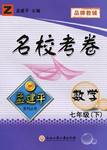题目内容
As an engineering student, I had a degree and three good job offers. I couldn’t help trembling when I heard about studies which showed that women are at a (n) 1 when it comes to math. However, I discovered: just because a subject is 2 to learn, it does not show you are not good at it. You just have to grit your teeth and work harder to get good at it. 3 you do, there’s a (an) 4 chance you will enjoy it more than anything else.
In eighth grade I took algebra (代数). On one test I got only 1 percent of the 5 answers. I failed the next one, too. I started to 6 maybe I’m just not good at this. I was lucky enough to have a teacher who didn’t take my bad grades as a judgment of my 7 , but 8 as an indication that I should study more. He 9 me aside and told me he knew I could do better. Success grows out of struggles to overcome difficulties. I 10 the following tests, and pulled my grade up to an A.
I studied a lot in college, too. I had moments of fear while sitting below the fluorescent lights in the 11 library on Saturday afternoons, when I 12 that the estrogen (雌性激素) in my body was 13 me from understanding thermodynamics (热动力学). But the 14 in my class had to work just as hard, and I knew that I couldn’t 15 to lose confidence in myself. I didn’t want to choose between my femininity (女人气) and a good career. 16 I reminded myself that those 17 , the ones that say math comes more naturally to men, are faulty.
Here’s a secret: math and science don’t go 18 to most people. No one was 19 born knowing calculus (微积分). But as a famous saying goes: Y nothing is difficult if you put your heart into it. A woman can learn anything a man can, but first she needs to know that she can do it, and then takes a leap of 20 .
1.A.advantage B.disadvantage C.trouble D.discomfort
2.A.enjoyable B.humorous C.simple D.difficult
3.A.Once B.Where C.Although D.Until
4.A.strong B.poor C.impossible D.few
5.A.wrong B.complete C.correct D.missing
6.A.think B.astonish C.know D.decide
7.A.marks B.standards C.characteristics D.abilities
8.A.extremely B.simply C.slightly D.especially
9.A.pulled B.led C.put D.pushed
10.A.designed B.attended C.got D.took
11.A.chemistry B.engineering C.biology D.geography
12.A.worried B.agreed C.knew D.realized
13.A.protecting B.awaking C.preventing D.attempting
14.A.girls B.boys C.students D.classmates
15.A.afford B.try C.help D.manage
16.A.Also B.But C.Though D.So
17.A.studies B.grades C.students D.experiments
18.A.actively B.easily C.difficultly D.gradually
19.A.never B.ever C.even D.often
20.A.honesty B.knowledge C.reality D.faith
BDAAC ADBAD BACBA DACBD

 孟建平名校考卷系列答案
孟建平名校考卷系列答案
Steve Fossett did not really look like an adventurer, but he reached some of the most difficult goals in sailing and flying.
Fossett was most proud of being the first person to fly around the world alone in a hot-air balloon. To make a trip around the world alone, it was necessary to have an improved autopilot (自动驾驶仪) device. Fossett had one of his team members develop a more advanced balloon autopilot that would allow him to sleep and do other tasks while flying safely.
Steve Fossett attempted the hot-air balloon trip around the world six times. This was not easy to do. He flew in the balloon’s capsule (密封舱) that was too small to stand upright. During his fourth attempt in 1998, he was almost killed during a storm off the coast of Australia. He fell 9,000 meters into the Coral Sea with his balloon’s capsule on fire. He was later rescued at sea.
Fossett successfully made the trip in 2002. The trip started and ended in Australia. He traveled more than 33,000 kilometers for more than 14 days. On this flight, Fossett set other records including a speed record of 322 kilometers per hour. One main problem with earlier balloon flights was the threat of dangerous storms. A team of weather experts e-mailed and talked to Fossett by a satellite telephone to help him avoid such weather.
Steve Fossett’s hot-air balloon is now at the Smithsonian’s National Air and Space Museum in Washington, D.C. It is there as an example for other people to try and succeed in doing something important to them.
【小题1】What did Steve Fossett specially prepare for the trip around the world?
| A.He made the balloon’s capsule bigger. |
| B.He had an autopilot impvoved. |
| C.He formed a team to fly with him. |
| D.He improved the balloon’s engine. |
| A.communicating with experts |
| B.using his rich experience |
| C.inventing a satellite phone |
| D.consulting other adventurers |
| A.patient and careful | B.modest and easy-going |
| C.brave and determined | D.energetic and kind-hearted |
| A.He was rescued during the trip. |
| B.He lost his way over the sea. |
| C.It lasted over three weeks. |
| D.He set a speed record of balloon flight. |